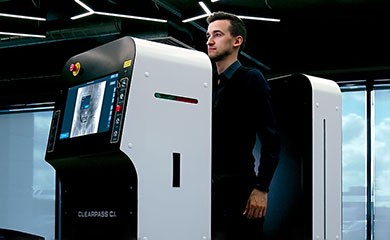This website:
Other websites:
Choose website
Guarding the Invisible: An Essential Guide to Ensuring Safety in a Radiation-filled Environment


Guarding the Invisible: An Essential Guide to Ensuring Safety in a Radiation-filled Environment
LINEV Systems has introduced the FLOWD X-ray flaw detection system, a groundbreaking technology that uses sophisticated algorithms to glean extensive data on the uniformity of test materials. The system works by using a thin fan beam of radiation to scan large sections of an object, along with a linear dual-energy detector.
Traditional procedures for examining the attributes of X-ray protective attire, whether in medical settings or through methods to evaluate attenuation properties, come with certain limitations. However, LINEV Systems has introduced the FLOWD X-ray flaw detection system, a groundbreaking technology that uses sophisticated algorithms to glean extensive data on the uniformity of test materials. The system works by using a thin fan beam of radiation to scan large sections of an object, along with a linear dual-energy detector. This innovative system efficiently tackles the shortcomings of older methods. Moreover, it introduces an advanced, highly accurate method for evaluating attenuation characteristics, which could revolutionize the field of X-ray protective clothing testing. The FLOWD Protective clothing X-ray testing machine is a part of the LINEV System’s GREEN Non-Destructive Testing.

The Health Impacts of Radiation
When an X-ray photon makes contact with the human body, it collides with the atoms found within our cells. This collision can cause electrons to be ejected from the atoms, disturbing their electrical equilibrium and converting them into ions, or electrically charged atoms. These altered atoms can cause disturbances at the cellular level, leading to molecular damage and DNA disruption. If enough atoms and cells are impacted, this can result in various detectable health issues, such as:
– Radiation Sickness:
High levels of X-ray radiation exposure can result in radiation sickness. These symptoms of illness range from nausea, vomiting, fatigue and hair loss to serious harm to bone marrow and immune systems in severe cases.
– Radiation Burns:
Extended or intense exposure to X-rays can cause burns similar to those caused by the sun. The extent of these burns can vary from mild redness and irritation to severe blistering and tissue damage.
– Genetic Mutations:
X-rays can inflict damage on the DNA molecules within cells. This damage can cause genetic mutations, which may elevate the risk of genetic disorders or birth defects in the individual exposed to the radiation and their offspring.
– Radiation-Induced Cancers:
Chronic exposure to high doses of radiation – including X-rays – increases your risk for various cancers For instance, repeated dental X-rays without adequate shielding could potentially heighten that risk and contribute to cancerous growths such as oral carcinomas.
Health issues resulting from exposure to X-ray radiation depend on several variables such as duration and intensity of exposure, exposure target parts of the body exposed and susceptibility levels for individuals. Medical professionals reduce these risks by adhering to safety protocols and employing shielding techniques during X-ray procedures.
Protective Apparel for Radiation Shielding
Often referred to as lead aprons or radiation protection aprons, X-ray protective clothing is crucial for safeguarding individuals from detrimental X-ray radiation exposure. These garments are used extensively in medical and industrial environments where exposure to radiation could pose a risk. They are typically made from lead or lead-equivalent materials like lead composite or non-lead substitutes with high atomic numbers and densities, making them efficient at absorbing and scattering high-energy X-ray photons. Lead or lead-equivalent materials block or deflect X-ray photons that come into contact with them, reducing the amount that can penetrate and cause cell damage due to radiation exposure. This significantly decreases the risks associated with radiation. Effective protective garments are influenced by factors like thickness of materials used, energy sources used and duration of exposure time. Therefore, the use of these protective garments should be integrated into a comprehensive radiation protection program that also includes time/distance/shielding strategies to ensure its efficacy in reducing radiation risks.
Radiology Personal Protective Equipment Varieties
Radiology PPE is designed to shield healthcare workers and patients from detrimental radiation exposure. The choice of radiology PPE can differ based on the type of radiation, the level of exposure, and the specific procedure being conducted. Here are some commonly used types of radiology PPE:
Radiation Glasses: Also referred to as lead glasses, these provide a shield for the eyes against radiation. Lenses made of leaded glass absorb X-rays and keep them away from reaching sensitive cells of the eye, protecting delicate cells in this way.
Lead Gloves: These are utilized to protect the hands, which frequently find themselves near the source of radiation during specific procedures. Like lead aprons, they are typically made of lead or lead-equivalent materials.
Lead Caps: These offer safeguarding for the head, which is particularly crucial during operations that could expose the head to dispersed radiation..
Lead Aprons: These are the most recognized piece of radiology PPE, providing significant protection from X-rays. They come in various designs and sizes, including full wrap-around and vest-skirt styles. Modern aprons often use lead-composite materials, which are lighter than pure lead but offer comparable protection.
Thyroid Shields: These are donned around the neck to shield the thyroid gland, a region especially vulnerable to radiation. Thyroid protectors can either be worn independently or coupled with a lead apron.
Radiation Shields: These are not attire but tools deployed within the work environment to insulate workers from exposure to radiation. They comprise movable barricades, table drapes, and Bucky slot protectors, which are positioned tactically to soak up scattered radiation.
Dosimeters: While not a protective shield, dosimeters are a critical part of PPE. These devices measure the amount of radiation exposure over time, ensuring it stays within safe limits.
Understanding the Impact of Radiation on Health
Radiation, such as that from X-rays, is a potential health hazard. When an X-ray photon collides with a person’s body, it interacts with the atoms within their cells. These collisions can knock electrons from atoms, altering their electronic balance and converting them into ions. The process of ionization can damage cells by damaging molecules and disrupting the DNA. Depending on the extent of the damage, various health conditions may arise, such as burns or radiation sickness. Radiation exposure increases your risk for cancer or other long-term illnesses.
The effects of radiation exposure hinge upon a variety of critical factors, encompassing the type and dosage of radiation, the duration of exposure, and the individual’s age and general health. As such, it becomes imperative to adopt precautionary measures in order to curtail radiation exposure to the greatest extent possible. If there are concerns about potentially reaching harmful radiation levels, seeking immediate medical attention is of paramount importance. Prioritizing safety and proactive healthcare remains fundamental in dealing with radiation exposure.
LINEV Systems is a forward-thinking technology company striving to redefine safety standards in radiation-prone environments. Renowned for its innovative approach, the company has developed technologies like the FLOWD X-ray flaw detection system that signifies a substantial advance in testing the effectiveness of X-ray protective clothing. Using unique algorithms and a dual-energy detector, the FLOWD system offers comprehensive and accurate data about the homogeneity of test materials. What sets LINEV Systems apart is not just its emphasis on ground-breaking technologies but also its focus on creating user-friendly designs that demystify complex procedures. This balance between cutting-edge innovation and user-centric design positions LINEV Systems as a trailblazer in radiation safety technology.LINEV Systems stands out in its field as an industry leader by emphasizing the improvement of individuals’ well being who work in radiation-exposed environments and mitigating health risks associated with radiation exposure.

Protective clothing X-ray testing machine
The Health Impacts of Radiation
When an X-ray photon makes contact with the human body, it collides with the atoms found within our cells. This collision can cause electrons to be ejected from the atoms, disturbing their electrical equilibrium and converting them into ions, or electrically charged atoms. These altered atoms can cause disturbances at the cellular level, leading to molecular damage and DNA disruption. If enough atoms and cells are impacted, this can result in various detectable health issues, such as:
– Radiation Sickness:
High levels of X-ray radiation exposure can result in radiation sickness. These symptoms of illness range from nausea, vomiting, fatigue and hair loss to serious harm to bone marrow and immune systems in severe cases.
– Radiation Burns:
Extended or intense exposure to X-rays can cause burns similar to those caused by the sun. The extent of these burns can vary from mild redness and irritation to severe blistering and tissue damage.
– Genetic Mutations:
X-rays can inflict damage on the DNA molecules within cells. This damage can cause genetic mutations, which may elevate the risk of genetic disorders or birth defects in the individual exposed to the radiation and their offspring.
– Radiation-Induced Cancers:
Chronic exposure to high doses of radiation – including X-rays – increases your risk for various cancers For instance, repeated dental X-rays without adequate shielding could potentially heighten that risk and contribute to cancerous growths such as oral carcinomas.
Health issues resulting from exposure to X-ray radiation depend on several variables such as duration and intensity of exposure, exposure target parts of the body exposed and susceptibility levels for individuals. Medical professionals reduce these risks by adhering to safety protocols and employing shielding techniques during X-ray procedures.
Protective Apparel for Radiation Shielding
Often referred to as lead aprons or radiation protection aprons, X-ray protective clothing is crucial for safeguarding individuals from detrimental X-ray radiation exposure. These garments are used extensively in medical and industrial environments where exposure to radiation could pose a risk. They are typically made from lead or lead-equivalent materials like lead composite or non-lead substitutes with high atomic numbers and densities, making them efficient at absorbing and scattering high-energy X-ray photons. Lead or lead-equivalent materials block or deflect X-ray photons that come into contact with them, reducing the amount that can penetrate and cause cell damage due to radiation exposure. This significantly decreases the risks associated with radiation. Effective protective garments are influenced by factors like thickness of materials used, energy sources used and duration of exposure time. Therefore, the use of these protective garments should be integrated into a comprehensive radiation protection program that also includes time/distance/shielding strategies to ensure its efficacy in reducing radiation risks.
Radiology Personal Protective Equipment Varieties
Radiology PPE is designed to shield healthcare workers and patients from detrimental radiation exposure. The choice of radiology PPE can differ based on the type of radiation, the level of exposure, and the specific procedure being conducted. Here are some commonly used types of radiology PPE:
Radiation Glasses: Also referred to as lead glasses, these provide a shield for the eyes against radiation. Lenses made of leaded glass absorb X-rays and keep them away from reaching sensitive cells of the eye, protecting delicate cells in this way.
Lead Gloves: These are utilized to protect the hands, which frequently find themselves near the source of radiation during specific procedures. Like lead aprons, they are typically made of lead or lead-equivalent materials.
Lead Caps: These offer safeguarding for the head, which is particularly crucial during operations that could expose the head to dispersed radiation..
Lead Aprons: These are the most recognized piece of radiology PPE, providing significant protection from X-rays. They come in various designs and sizes, including full wrap-around and vest-skirt styles. Modern aprons often use lead-composite materials, which are lighter than pure lead but offer comparable protection.
Thyroid Shields: These are donned around the neck to shield the thyroid gland, a region especially vulnerable to radiation. Thyroid protectors can either be worn independently or coupled with a lead apron.
Radiation Shields: These are not attire but tools deployed within the work environment to insulate workers from exposure to radiation. They comprise movable barricades, table drapes, and Bucky slot protectors, which are positioned tactically to soak up scattered radiation.
Dosimeters: While not a protective shield, dosimeters are a critical part of PPE. These devices measure the amount of radiation exposure over time, ensuring it stays within safe limits.
Understanding the Impact of Radiation on Health
Radiation, such as that from X-rays, is a potential health hazard. When an X-ray photon collides with a person’s body, it interacts with the atoms within their cells. These collisions can knock electrons from atoms, altering their electronic balance and converting them into ions. The process of ionization can damage cells by damaging molecules and disrupting the DNA. Depending on the extent of the damage, various health conditions may arise, such as burns or radiation sickness. Radiation exposure increases your risk for cancer or other long-term illnesses.
The effects of radiation exposure hinge upon a variety of critical factors, encompassing the type and dosage of radiation, the duration of exposure, and the individual’s age and general health. As such, it becomes imperative to adopt precautionary measures in order to curtail radiation exposure to the greatest extent possible. If there are concerns about potentially reaching harmful radiation levels, seeking immediate medical attention is of paramount importance. Prioritizing safety and proactive healthcare remains fundamental in dealing with radiation exposure.
LINEV Systems is a forward-thinking technology company striving to redefine safety standards in radiation-prone environments. Renowned for its innovative approach, the company has developed technologies like the FLOWD X-ray flaw detection system that signifies a substantial advance in testing the effectiveness of X-ray protective clothing. Using unique algorithms and a dual-energy detector, the FLOWD system offers comprehensive and accurate data about the homogeneity of test materials. What sets LINEV Systems apart is not just its emphasis on ground-breaking technologies but also its focus on creating user-friendly designs that demystify complex procedures. This balance between cutting-edge innovation and user-centric design positions LINEV Systems as a trailblazer in radiation safety technology.LINEV Systems stands out in its field as an industry leader by emphasizing the improvement of individuals’ well being who work in radiation-exposed environments and mitigating health risks associated with radiation exposure.

















